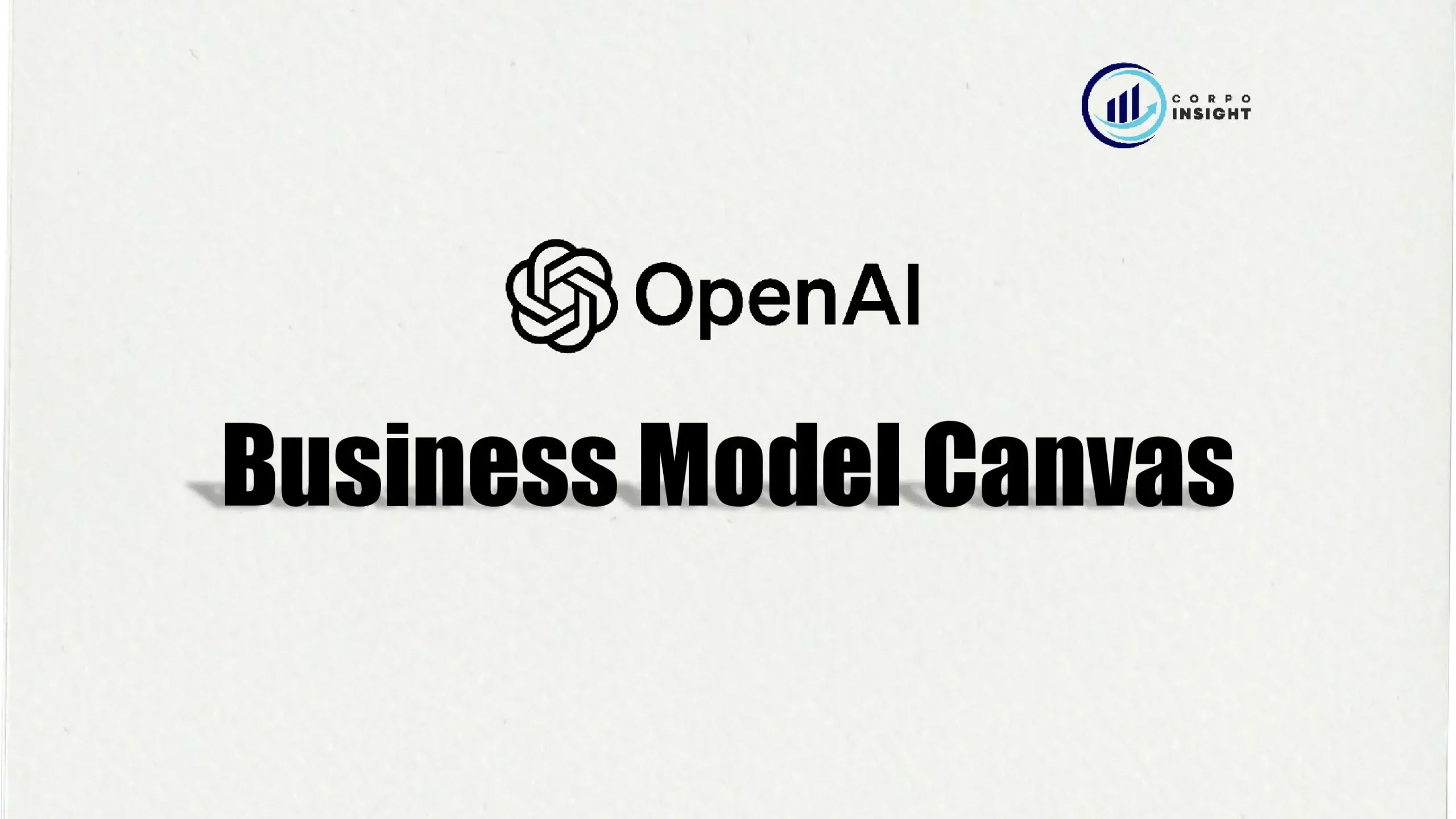OpenAI Business Model Canvas 2024
Although OpenAI began as a non-profit research laboratory in 2015, it has evolved into a pioneering force in artificial intelligence, developing transformative models like GPT and DALL-E while sparking intense debates about AI safety and ethics. In this OpenAI Business Model Canvas, I will identify its customer segments, value proposition, revenue streams, channels, customer relationships, key activities, key resources, key partners, and cost structure.
Interesting fact!
In its early days, OpenAI used an unusual approach to computing power – they built their first AI training cluster using off-the-shelf consumer graphics cards typically used for gaming, rather than specialized hardware.
OpenAI Competitors
Microsoft Azure AI | Google AI/DeepMind | Anthropic | Cohere | Meta AI | IBM Watson | Amazon AWS AI | Stability AI | Mistral AI | Inflection AI
Customer Segments – OpenAI Business Model Canvas

Enterprise Organizations: Major corporations like Microsoft, Salesforce, and Morgan Stanley leverage OpenAI’s API services to integrate advanced AI capabilities into their operations, particularly through custom GPT models that enhance customer service, data analysis, and decision-making processes.
Software Developers and Tech Companies: Independent developers and technology firms, ranging from startups like Duolingo to established platforms like Shopify, utilize OpenAI’s API to build innovative applications, with over 2 million developers currently integrating GPT functionalities into their solutions.
Research Institutions and Academia: Universities and research centers worldwide, including MIT and Stanford, collaborate with OpenAI to advance AI research and development, while simultaneously using tools like ChatGPT Plus for educational purposes and academic exploration.
Individual Consumers and Professionals: Creative professionals, writers, and knowledge workers comprise a significant segment of OpenAI’s customer base, with ChatGPT achieving over 100 million monthly active users who utilize the platform for various tasks and creative endeavors.
Small and Medium Enterprises: Local businesses and growing companies increasingly adopt OpenAI’s solutions through platforms like Microsoft’s Copilot for business process automation and customer engagement, demonstrating the democratization of AI technology across market segments.
Value Proposition – OpenAI Business Model Canvas

Advanced AI Accessibility: OpenAI democratizes cutting-edge AI technology by offering scalable solutions, from the free ChatGPT that serves millions daily to enterprise-level GPT-4 API access, making sophisticated AI capabilities available to both individual users and large organizations.
Innovation Leadership: Through continuous breakthroughs like GPT-4V and DALL-E 3, OpenAI maintains its position at the forefront of AI development, providing customers with access to state-of-the-art multimodal AI models that outperform traditional solutions in various tasks.
Customization and Integration: The company’s flexible API architecture and custom GPT builder enable organizations to create tailored AI solutions, while seamless integration capabilities have led to successful implementations across diverse platforms, from Microsoft’s suite to Shopify’s e-commerce solutions.
Safety and Reliability: OpenAI’s commitment to responsible AI development, evidenced by its extensive safety protocols and alignment research, provides customers with trustworthy AI solutions that adhere to ethical guidelines while maintaining high-performance standards.
Cost-Effective Scaling: Their tiered pricing model, ranging from free ChatGPT to enterprise solutions, allows businesses to scale AI implementation cost-effectively, with API costs decreasing as usage increases, making advanced AI accessible to organizations of all sizes.
Revenue Streams – OpenAI Business Model Canvas

API Licensing and Usage Fees: OpenAI generates substantial revenue through its API services, charging based on token usage and model complexity, with GPT-4 API pricing at $0.03 per 1K input tokens and $0.06 per 1K output tokens.
ChatGPT Plus Subscriptions: The premium subscription service, priced at $20 monthly, offers advanced features and priority access to newer models, having reportedly generated over $1.3 billion in revenue by October 2023, with an estimated 2.5 million subscribers.
Enterprise Solutions and Partnerships: Strategic partnerships, particularly the multibillion-dollar collaboration with Microsoft, contribute significantly to revenue through enterprise-level implementations, custom solutions, and specialized AI model development for large organizations.
Research and Development Funding: While not a direct revenue stream, OpenAI secures substantial funding for R&D through investments and grants, with their latest funding round valuing the company at over $80 billion and attracting investments from major venture capital firms.
Custom GPT Marketplace: The newly launched GPT Store creates an additional revenue stream through revenue-sharing with GPT builders, though the specific financial impact is yet to be determined as the platform continues to evolve and grow.
Channels – OpenAI Business Model Canvas

Direct Digital Platforms: OpenAI’s primary distribution channel, chat.openai.com, serves millions of users directly, while their developer platform platform.openai.com provides API access and documentation, supporting over 2 million developers who integrate OpenAI’s technologies into various applications.
Strategic Partner Networks: Through significant partnerships, particularly with Microsoft, OpenAI extends its reach via integrated services like Microsoft Azure OpenAI Service and GitHub Copilot, enabling enterprise-level distribution while maintaining control over its core technology.
Developer Ecosystem: The comprehensive API documentation, extensive developer forums, and GitHub repositories serve as crucial channels for technical implementation, while the newly launched GPT Store creates an additional distribution pathway for custom AI solutions.
Enterprise Sales Teams: OpenAI maintains dedicated enterprise sales channels that facilitate direct relationships with major corporations, providing customized solutions and specialized support for large-scale implementations across various industries and use cases.
Educational and Research Institutions: Through academic partnerships and research collaborations, OpenAI distributes its technology to universities and research centers, while simultaneously gathering valuable feedback and use cases that inform future development.
Customer Relationships – OpenAI Business Model Canvas

Self-Service Digital Interaction: Through the intuitive ChatGPT interface and comprehensive developer portal, OpenAI enables users to independently explore, experiment, and implement AI solutions, with over 100 million weekly active users engaging through direct digital platforms.
Community-Driven Support: The company maintains robust online forums, GitHub repositories, and developer communities that foster collaborative problem-solving, knowledge sharing, and continuous feedback loops, which significantly enhance user engagement and product refinement.
Personalized Enterprise Engagement: For high-tier clients like Microsoft and enterprise customers, OpenAI provides dedicated account management, custom integration support, and specialized consulting services that transform transactional relationships into strategic technological partnerships.
Continuous Product Evolution: By regularly releasing model updates, incorporating user feedback, and transparently communicating technological advancements, OpenAI cultivates a relationship of trust and ongoing collaboration with its diverse user base across individual and institutional segments.
Research and Academic Collaboration: Through strategic partnerships with leading universities and research institutions, OpenAI maintains sophisticated relationships that extend beyond traditional customer interactions, fostering global knowledge exchange and responsible AI development.
Key Activities – OpenAI Business Model Canvas

AI Model Research and Development: OpenAI continuously pushes technological boundaries, developing sophisticated models like GPT-4 and DALL-E 3, which represent unprecedented advancements in multimodal AI capabilities, requiring complex computational infrastructures and massive computational investments.
Ethical AI Safety and Alignment: Through rigorous research initiatives, OpenAI dedicates substantial resources to developing AI systems that are safe, transparent, and aligned with human values, conducting extensive testing, and implementing robust governance frameworks for responsible technological innovation.
API Platform and Infrastructure Management: The company maintains a sophisticated technological ecosystem, providing scalable API services that enable developers and enterprises to seamlessly integrate advanced AI capabilities across diverse computational environments and use cases.
Continuous Model Training and Optimization: OpenAI invests heavily in iterative machine learning processes, continuously refining existing models through advanced training techniques, user feedback integration, and sophisticated algorithmic improvements that enhance performance and reduce potential biases.
Strategic Partnerships and Ecosystem Development: By cultivating relationships with leading technology companies, research institutions, and enterprise clients, OpenAI creates a comprehensive innovation network that accelerates AI technology adoption and drives global technological transformation.
Key Resources – OpenAI Business Model Canvas

Intellectual Property and AI Models: OpenAI’s groundbreaking proprietary models like GPT-4, DALL-E 3, and their underlying technological architectures represent their most critical intellectual resource, with billions invested in development and unique algorithmic innovations.
Advanced Computational Infrastructure: Leveraging massive GPU clusters and cloud computing resources, primarily through Microsoft Azure partnerships, OpenAI maintains an unprecedented computational capability that enables training of complex AI models requiring exabytes of processing power.
Human Capital and Research Talent: The organization attracts world-class AI researchers, machine learning experts, and innovators like Sam Altman and Ilya Sutskever, whose collective expertise drives technological breakthroughs and maintains OpenAI’s competitive technological edge.
Strategic Financial Resources: With over $10 billion in funding, including significant investments from Microsoft and a valuation exceeding $80 billion, OpenAI possesses substantial financial resources to fund extensive research, development, and global expansion initiatives.
Data Ecosystem and Training Datasets: OpenAI’s curated, extensive training datasets—comprising diverse multilingual, multidisciplinary information—serve as a foundational resource enabling sophisticated model training and continuous improvement across various AI applications.
Key Partners – OpenAI Business Model Canvas

Microsoft Strategic Alliance: Through a multibillion-dollar partnership, Microsoft provides critical cloud infrastructure, significant financial investment, and global distribution channels, integrating OpenAI’s technologies across Azure, GitHub, and Microsoft’s comprehensive enterprise ecosystem.
Technology and Cloud Providers: Strategic collaborations with leading cloud platforms like Google Cloud and Amazon Web Services enable OpenAI to leverage advanced computational resources, ensuring scalable and efficient AI model development and deployment.
Academic and Research Institutions: Partnerships with renowned universities including MIT, Stanford, and Carnegie Mellon facilitate cutting-edge research, knowledge exchange, and collaborative efforts in developing responsible and innovative artificial intelligence technologies.
Enterprise Technology Partners: Collaborations with global corporations like Salesforce, Shopify, and Databricks demonstrate OpenAI’s commitment to creating integrated AI solutions that transform business processes and technological capabilities across diverse industry sectors.
Developer and Innovation Ecosystems: Through extensive developer networks, API partnerships, and the newly launched GPT Store, OpenAI cultivates a global community of innovators who continuously expand and enhance AI technological applications and implementations.
Cost Structure – OpenAI Business Model Canvas

Computational Infrastructure Expenses: Massive investments in high-performance GPU clusters and cloud computing resources represent OpenAI’s most significant operational cost, with estimated annual computational expenses exceeding $700 million for training and maintaining advanced AI models.
Research and Development Investment: Substantial financial resources are allocated toward continuous technological innovation, attracting world-class AI researchers and machine learning experts, with R&D expenditures representing approximately 60-70% of the company’s total operational budget.
Talent Acquisition and Compensation: Competitive salaries for elite AI researchers and engineers, including top-tier compensation packages and equity options, constitute a significant portion of OpenAI’s fixed costs, reflecting the premium placed on exceptional human capital.
Cloud Services and Technological Infrastructure: Ongoing expenses for maintaining sophisticated cloud services, data storage, and computational networks through partnerships with Microsoft Azure and other cloud providers represent a substantial recurring operational expenditure.
Regulatory Compliance and Ethical AI Development: Investments in safety research, ethical AI frameworks, and comprehensive governance mechanisms generate additional operational costs while ensuring responsible technological development and maintaining stakeholder trust.
Summary of OpenAI Business Model Canvas

Conclusion on OpenAI Business Model Canvas
OpenAI’s revolutionary business model transcends traditional technology frameworks by seamlessly integrating advanced AI research, ethical innovation, and strategic partnerships. By democratizing cutting-edge artificial intelligence through scalable, accessible solutions, the company has transformed from a non-profit research initiative to a global technological powerhouse, driving unprecedented value across the enterprise, academic, and individual customer segments while maintaining a commitment to responsible AI development.

This is Ahsanul Haque, someone very passionate about digital marketing, SEO, and Data Analytics and founder of the Analytics Empire and currently pursuing my major in marketing at Bangladesh University of Professionals.







